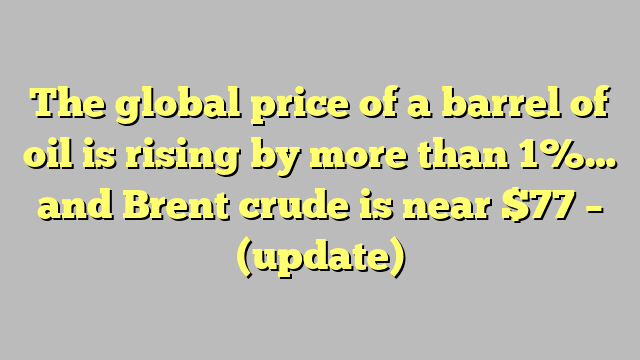The price of a barrel of oil rose globally by more than 1% at the end of trading today, Wednesday, June 7 (2023), in an attempt to compensate for the losses it suffered in the previous session, as fears of a shortage of supplies were overwhelmed after Saudi Arabia, the largest exporter of crude oil, pledged to cut An additional one million barrels per day during next July on weak Chinese export data and high US fuel stocks.
And the US Energy Information Administration raised crude oil price expectations by about 13% during the next year (2024), and strengthened its estimates for the year 2023, after the OPEC + alliance decided to stabilize the supply reduction policy, with an adjustment to the base month through which the production quotas of members of the alliance are calculated, starting from ( 2024).
The global price of a barrel of oil today
At the end of the session, benchmark Brent crude futures – August 2023 delivery – rose by 0.9%, to $76.95 a barrel.
At the same time, futures contracts for US West Texas Intermediate crude – delivery July 2023 – increased by 1.1%, to $ 72.53 a barrel, according to figures seen by the specialized energy platform.
And the global price of a barrel of oil had recorded, during trading yesterday, Tuesday, June 6, a decline for the first time in 4 consecutive sessions, giving up the gains it made during recent trading.
Oil price analysis
The two benchmarks jumped more than a dollar last Monday, supported by Saudi Arabia’s decision to cut production by one million barrels per day to 9 million barrels per day in July.
Analyst at Philip Nova, Priyanka Sachdeva, said: “Fears of recession affect the price of a barrel of oil globally, as more and more dismal economic readings indicate a slowdown, keeping a lid on oil prices, which led to the erosion of gains supported by OPEC + moves.”
The OPEC + alliance confirms that its moves do not aim to keep oil prices at certain levels, but rather aim to stabilize the markets in a way that serves the interests of consumers and producers.

US oil stocks
Crude oil inventories in the United States fell by about 0.5 million barrels during the past week, according to the weekly report issued by the US Energy Information Administration.
While gasoline inventories in the United States rose by about 2.7 million barrels, distillate inventories increased by about 5.1 million barrels in the week ending June 2.
The unexpected build-up of inventories raised concerns about fuel consumption by the world’s largest oil consumer, especially as travel demand grew over the Memorial Day weekend.
Meanwhile, the US Energy Information Administration said that US crude oil production this year will rise faster, and that the increase in demand will subside compared to previous expectations.
Oil price forecast
“The market has digested the news of the Saudi production cut, and investors are now reluctant to take a big stance due to the divergent economic outlook and indicators in the US and China,” said Hiroyuki Kikukawa, president of NS Trading, a unit of Nissan Securities.
Chinese official data on Wednesday showed its exports contracted much faster than expected in May and imports fell, albeit at a slower pace, as manufacturers struggled to find demand abroad and domestic consumption remained sluggish.
However, some analysts predicted that Saudi Arabia’s voluntary cut – the largest in the kingdom in years – would set a floor in the price of a barrel of oil globally, although it was unlikely to support a sustainable increase in prices to the high range of the 80s and 90s per barrel.
“We expect the price of a barrel of oil globally to test the upward trend as we enter the summer driving season in the United States,” Kikukawa said.
He added that the tightening of global supply and the plans of the United States to buy crude to refill the strategic oil reserves will limit the downward trend, according to Reuters.

Leave a Reply